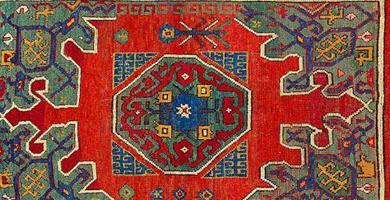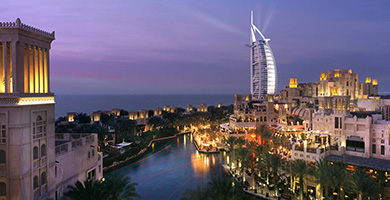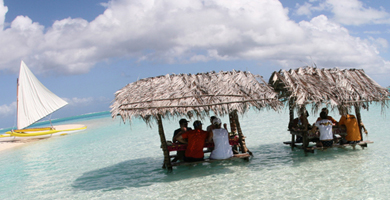EGYPT: Is It Safe Yet?
The unrest of the Arab Spring has made many balk at the idea of traveling to Egypt, a benchmark experience for the true traveler. Here’s our update from the frontline.
*Editor’s note: This post was originally scheduled to run last month. A new cycle of unrest in Egypt at the time convinced us to delay the piece. Recent reports, however, including this great update by veteran travel expert Peter Greenberg, coupled with positive reports from our contacts in the region as we approach the year anniversary of event at Tahrir Square, assured us the time to consider a trip to Egypt is now, while deals are plentiful and lines at antiquities short.
What’s it like to visit a country post-revolution? How does it feel to be somewhere that’s still in flux; wary, and nervous but also excited and hopeful at the same time? My husband and I had the chance to find out on our recent trip to Egypt in November. It’s been his dream since the 4th grade to see the pyramids, and our round-the-world trip itinerary would bring us too close to the country to pass up the chance to pop in, turbulent times or not. So despite parental concerns, looming elections and US State Department warnings, we spent 4 days exploring the sites and meeting the people of Cairo, enjoying a rare chance to hear “man on the street” reactions during such an exciting time in this country’s vast history.
First, a disclaimer: our experience in Cairo was a snapshot in time, and the situation on the ground can change day by day. We visited during the Islamic holiday of Eid al-Adha, and the locals were celebratory and festive. There were no protests during our visit. But as common sense dictates, before traveling, check the latest news reports, blogs, and State Department warnings, and be aware of the risks of going to any country during a volatile political period. That said, Egyptians love tourists – especially Americans – and are hungry for visitors since the tourism industry crashed after the revolution. Be smart, be aware, and steer clear of protests if you decide to visit Egypt in the near future.
Day 1: Cairo Exploration
We landed early on a Sunday morning, groggy and exhausted after our overnight flight. Our budget Cairo hotel sent a complimentary driver for us – a perk that’s easier to get these days – and we headed for the city. After a recharging nap, we explored on foot: starting with Tahrir Square, we crossed the Nile and headed into the leafy Zamalek district, all the while fielding calls of “Hello!” from school kids on holiday. Most tourists are encouraged to stay in Zamalek as it’s a bit safer, calmer and quieter than most parts of Cairo. We opted for downtown Cairo for budget considerations – our hotel room was one-third the cost of the cheapest hotel on Zamalek – and while Zamalek is slightly nicer, we didn’t regret our decision.
Cairo is chaotic, messy, dirty and noisy. Drivers don’t follow western norms of traffic lanes, stoplights, crosswalks or common sense; instead, they use horns constantly to signal where they are, where they’re going, and what they plan to do. Garbage overflows on the streets, spills into the canals, and pools on sidewalks. Surprisingly, for a country that receives millions of tourists annually, the locals aren’t used to seeing foreigners walk the streets: most visitors are driven in private cars or tour buses from their upscale hotel to the archeological sites to a tourist restaurant and back to their hotel; because of this, outsiders on the streets are a novelty to be gawked at, talked to and photographed. It’s also a fairly religious country, in customs and beliefs. The majority of Egyptian women cover their skin completely, except for their faces. As a fair-skinned western woman who favors t-shirts in hot climates, I got more looks and comments here than in just about any other country I’ve visited. I never felt unsafe, but I mention this as a note to fellow female travelers – you may get more attention than you’re used to receiving from strangers.
What I can’t wrap my head around is that despite the filth, the chaos, the constant attention and the craziness, the Cairenes turned out to be among the friendliest people we’ve met anywhere in the world. Walking down the street, entering and leaving businesses and restaurants, in and out of taxis, we heard a nearly nonstop chorus of “Hello! Welcome! Welcome to Egypt!” While some just wanted our business, most genuinely meant the greeting. From young and old, male and female, we heard this refrain our entire time in Cairo.
Day 2: The Egyptian Museum
After a good nights’ sleep we felt prepared to visit the Egyptian Museum. The museum has been described as “an embarrassment of riches,” and indeed, the halls are stuffed with incredible, ancient artifacts ranging from larger-than-life royal sculptures to case after case of sarcophagi to near-perfect centuries-old papyrus manuscripts to royal mummies. Any other museum in the world would pay an arm and a leg just to host a few of these wonders, while the Egyptian Museum seems almost nonchalant about their stash. Many artifacts lay out in the open, accessible to curious fingers and unprotected from the elements. Very few items have descriptions, and the jumbled immensity of the museum makes hiring a guide – or downloading an audio tour for your mp3 player – more appealing. Freelance guides are available for a negotiated fee outside and inside the museum.
Behind the museum looms a blackened, recently burned building. We later learned these were offices of former president Hosni Mubarak’s National Democratic Party, destroyed by protestors during the revolution. There are various reports of the looting that took place at the museum during the revolution, with some people telling us many artifacts went missing, others saying no, it was only the store and cafe area that was ransacked. All sides agree that numerous Egyptian treasures were appropriated by the former ruling party, particularly the head of the Supreme Council of Antiquities, and no one knows how much of the country’s history has been lost to greedy aristocrats or sold on the black market.
For lunch, an expat suggested we try koshary, a local specialty, at the Cairo favorite Abou Tarek. There’s only one thing on the menu here, and the only decisions to be made are small or large, and spicy or mild. Koshary reminded me of Middle Eastern spaghetti: a generous pile of pasta and noodles topped with a thick tomato sauce, fried onions, lentils and chickpeas. Poured over everything is a bit of garlic vinegar and a pinch of hot sauce. The hearty, flavorful meal will set you back about $1 US per person.
Day 3: Pyramids!
It was dream come true time for my husband, who’d been anxious to see the last remaining Wonder of the Ancient World for almost as long as he can remember. We booked a driver and an English-speaking guide through our hotel; after shopping around for quotes, they offered us the best deal. It turned out to be the same driver who did our airport pick-up, and our well-informed guide was a history and hieroglyphic buff who told us almost as much about his life as a Muslim as about ancient Egyptian culture. Starting at 8am, we visited the four major archeological sites near Cairo: Dahshur, Sakkara, Memphis and Giza. This is a fairly standard day tour from Cairo; most bus tours just do three of the four sites, but with a private car you’ll have the chance to hit all four. Visiting the sites turned out to be a perfect summary of our entire Egypt experience.
At Dahshur – which we had nearly to ourselves – we marveled at the isolated beauty of the Red Pyramid, a shining example of ancient architectural wisdom. After exploring the empty but eerie interior, we wandered around the exterior. Two military guards waved us over, took photos for us, posed us with their camel, then asked for a tip, baksheesh in Arabic. This is not uncommon in Egypt, but the experience neatly summarized how comfortable officials are with tips and bribes. Aside from this, Dahshur was a pristine, noncommercial site, beautiful in its solitude.
Memphis the ancient city is no more, but the site hosts a few impressive sculptures. The most memorable is the colossal horizontal likeness of pharaoh Ramesses II, a masterwork in stone with fine features and a serene expression. Within the grounds of the gated site, souvenir kiosks await customers, lending Memphis a highly commercialized feel – a symbol of the Egyptians’ drive to squeeze tourist dollars whenever possible, even at the risk of sullying ancient archeological sites.
Sakkara, a huge, ancient cemetery, holds numerous pyramids, tombs and monuments. One of the most unassuming is the Teti Pyramid, whose outside resembles little more than a mound of rubble. Inside, Teti boasts one of the most dramatic interiors of the pyramids open to the public, with walls covered in hieroglyphic writing and carved stars covering the ceiling.
Surrounding Sakkara are dozens of smaller tombs and burial shafts, some accessible to the public, some roped off. You never know what you’ll find in these unguarded structures: many still have exquisite carvings, scenes and hieroglyphics, while others could be hiding wild dogs. As exciting as it is to play Indiana Jones and pop in and out of the sites at will, pretending we are the first to discover the ruins, we couldn’t help but feel sad that these treasures of humankind are so open to destruction by visitors. If I had wanted to chip off a decorative section of a tomb and stash it in my purse, I don’t think a guard would have noticed, or cared. And if he had, the possibility of baksheesh might still let me take my souvenir home. The lack of care or concern for historical treasures was felt most strongly here, at the highly unguarded, vast burial grounds.
Finally, we headed to the most famous of the sites near Cairo: the Great Pyramids of Giza. By far, these were the largest and most impressive of the pyramids we had seen. They truly earned their status as a Wonder of the World. However, because of the holiday, and because it had been forbidden under the Mubarak regime for locals to visit the pyramids on holidays, the site was overrun with thousands of local visitors. Buying our entrance tickets nearly required a fight to get to the window; once inside, we had to jump aside as untrained horse and camel riders filled the walkways, and at the base of the pyramids, getting photos without hordes of people in the foreground was nearly impossible. While it was exciting to watch the locals celebrate a previously forbidden act, we were once again struck by how the lack of local authority is hurting the country’s most valuable assets. Visitors crawled all over the pyramids and relics, held picnics on top of ancient stones, and left trash wherever they liked. No one enforced any kind of respect or rule at the site, and according to the many locals with whom we spoke, this is a direct reaction to the revolution. The police refuse to interfere with the public or impose any rules, fearful of being attacked as they were during the protests.
Still, we managed to see the three pyramids of Giza up close, and entered the Third Pyramid. While not as impressive as the interior of Sakkara, this one had the most rooms. After a thigh-burning exit through the steep, long tunnel, our driver picked us up and brought us down to see the Sphinx, a massive, jaw-dropping sight. With the sun setting behind the Sphinx and the pyramids, and the garbage less visible in the fading light, this was the Egypt that we’d dreamed of visiting.
Day 4: Al Azhar Park
Needing to buy train tickets, we took the Cairo Metro to Ramses Station. The train station is at the newly named “Martyrs” metro stop – Al Shohadaa in Arabic – which replaced the former name: Mubarak. The metro is surprisingly clean, quiet, fast and efficient, a welcome relief from the bedlam happening on the streets above. Buying the train tickets was very easy, and within a few minutes we were on our way to Al Azhar Park, an oasis of greenery in the midst of the concrete cacophony. Since the holiday had not yet ended, the park was stuffed with Cairenes strolling, people-watching, meeting and picnicking. As the only foreigners in sight, we were asked to have our pictures taken with everyone from junior high boys to college students to mothers in headscarves who wanted us to pose with their babies and young children. Some friendly college students invited us to sit with them for a while. Chatting with these modern, excited scholars turned out to be one of the highlights of our Egyptian visit. We didn’t talk about politics and they didn’t want to sell us anything. They just wanted to know who our favorite bands and actors are, which TV shows we watch, what we think of Egypt, which perfume we wear; they simply sought to practice their English and spend an afternoon with some Americans. The spirit was festive and fun. Locals told us the park is normally much quieter – especially in the mornings – and is considered a favorite place to relax from the noise and bustle of the city.
From the modern city to the ancient sites, it’s clear the Egyptians have a long way to go in building a new nation and learning the responsibilities and respect that come with freedom. One driver told us, “We have never been free before; we don’t know what freedom means.” While all we spoke with were cautious and leery – of the upcoming elections, of how much power the military will try to grab, of how their countrymen will restore order – even the most wary exuded strong expressions of hope, optimism and excitement, lending one to believe that they will come through the other side stronger than ever. We look forward to hearing “Welcome to Egypt!” in a new, democratic nation.
All images: Kristen Kolada Caplan
Latest posts by Kristen Kolada Caplan
- EGYPT: Is It Safe Yet? - January 21, 2012
- The Time Is Ripe For Exploring Czech Wines - November 4, 2011












[…] EGYPT: Is it safe yet? Egyptian guard posing at Memphis […]